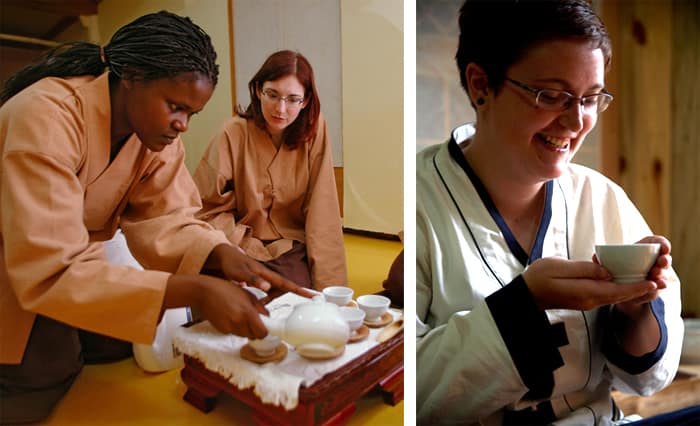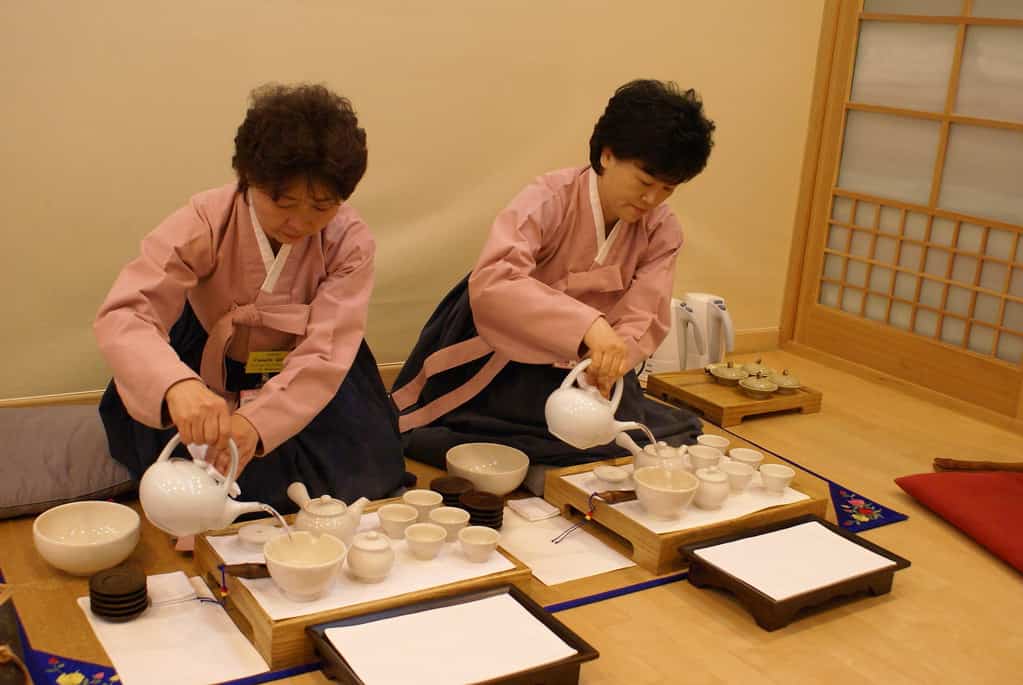Tea Time in Korea: Uncovering the Secrets of Dado Ceremony
The Korean Dado Ceremony is a traditional tea ceremony that holds great significance in Korean culture. It is a time-honored practice that has been passed down through generations, and it continues to be an important part of Korean society and daily life.
The ceremony involves the preparation and serving of tea, as well as the appreciation of its flavors and aromas. It is a time for relaxation, reflection, and connection with others.
In this article, we will explore the origins of the Dado Ceremony, its cultural significance, the different types of Korean tea, the tools and equipment used, the etiquette involved, the role of music and poetry, the health benefits of Korean tea, the art of tea making, and the future of the Dado Ceremony.
The Origins of Dado Ceremony
The Dado Ceremony has its roots in ancient Korean history. It is believed to have originated during the Three Kingdoms period (57 BC – 668 AD), when tea was introduced to Korea from China. Initially, tea was used for medicinal purposes and was consumed by Buddhist monks. Over time, it became more widely consumed by the general population, and the Dado Ceremony evolved as a way to appreciate and honor this beloved beverage.
During the Joseon Dynasty (1392-1910), the Dado Ceremony became more formalized and gained even greater importance in Korean society. It was considered a way to demonstrate one’s social status and refinement. The ceremony was often held in royal palaces and noble households, where elaborate rituals were performed to prepare and serve the tea.
The Significance of Dado Ceremony
The Dado Ceremony holds great cultural importance in Korea. It is seen as a way to promote harmony, mindfulness, and respect for nature. The ceremony encourages participants to slow down, be present in the moment, and appreciate the simple pleasures of life.
In Korean society, tea is often seen as a symbol of hospitality and friendship. It is a common practice to offer tea to guests as a sign of welcome and respect. The Dado Ceremony embodies these values and serves as a way to connect with others on a deeper level.
The Different Types of Korean Tea
Korean tea comes in a variety of flavors and types, each with its own unique characteristics and health benefits. Some of the most popular varieties include green tea, barley tea, ginger tea, and citron tea.
Green tea, or nokcha, is the most common type of Korean tea. It is made from the leaves of the Camellia sinensis plant and is known for its refreshing taste and numerous health benefits. Green tea is rich in antioxidants, which can help boost the immune system and protect against chronic diseases.
Barley tea, or boricha, is a caffeine-free herbal tea made from roasted barley grains. It has a nutty flavor and is often enjoyed as a refreshing summer beverage. Barley tea is believed to aid digestion, promote detoxification, and improve blood circulation.
Ginger tea, or saenggangcha, is made from fresh ginger root and has a spicy, warming flavor. It is often consumed during the winter months to help ward off colds and flu. Ginger tea is known for its anti-inflammatory properties and can help soothe an upset stomach.
Citron tea, or yujacha, is made from the fruit of the yuzu tree. It has a sweet and tangy flavor and is often enjoyed as a hot drink during the colder months. Citron tea is rich in vitamin C and antioxidants, which can help boost the immune system and improve overall health.
The Tools and Equipment Used in Dado Ceremony
The Dado Ceremony requires specific tools and equipment to properly prepare and serve the tea. These tools have deep symbolic meaning and are an integral part of the ceremony.
One of the most important tools is the tea pot, or jeongja. It is typically made of ceramic or porcelain and is used to steep the tea leaves. The tea pot is often adorned with intricate designs and patterns, reflecting the beauty and craftsmanship of Korean culture.
Another essential tool is the tea bowl, or jangdokdae. It is used to serve the tea and is often made of porcelain or pottery. The tea bowl is carefully chosen for its shape, size, and color, as these factors can influence the taste and aroma of the tea.
Other tools used in the Dado Ceremony include a tea strainer, a tea scoop, a tea whisk, and a water kettle. Each tool has its own specific purpose and adds to the overall experience of the ceremony.
The Etiquette of Dado Ceremony
The Dado Ceremony has its own set of etiquette rules that participants are expected to follow. These rules are designed to create a sense of harmony and respect during the ceremony.
First and foremost, it is important to show respect to the host of the ceremony. This can be done by bowing when entering the room and addressing the host with polite language.
When receiving a cup of tea, it is customary to hold it with both hands as a sign of respect. Before drinking, take a moment to appreciate the aroma and color of the tea. When taking a sip, do so quietly and without making any noise.
It is also important to show gratitude to the host by complimenting the tea and expressing appreciation for their efforts. After finishing the tea, it is customary to return the cup with both hands as a sign of respect.
The Role of Music and Poetry in Dado Ceremony
Music and poetry play an important role in enhancing the Dado Ceremony experience. Traditional Korean music, known as gugak, is often performed during the ceremony to create a serene and meditative atmosphere.
The music is typically played on traditional instruments such as the gayageum (a stringed instrument), the daegeum (a bamboo flute), and the janggu (a drum). The soothing melodies and rhythms of gugak help to create a sense of tranquility and relaxation.
Poetry is also an integral part of the Dado Ceremony. Participants often recite or listen to poems that reflect the beauty of nature and the appreciation of tea. These poems, known as sijo, are short and lyrical, and they capture the essence of the ceremony.
The Health Benefits of Korean Tea
Korean tea is not only delicious but also offers numerous health benefits. Many types of Korean tea are rich in antioxidants, which can help protect against chronic diseases such as heart disease, cancer, and diabetes.
Green tea, in particular, is known for its high antioxidant content. It has been shown to improve brain function, boost metabolism, and aid in weight loss. Green tea also contains catechins, which have been found to have anti-inflammatory and anti-cancer properties.
Barley tea is a caffeine-free herbal tea that is often consumed for its detoxifying properties. It can help flush out toxins from the body and improve digestion. Barley tea is also believed to have diuretic effects, which can help reduce water retention and bloating.
Ginger tea is known for its anti-inflammatory properties and can help relieve pain and inflammation in the body. It is often consumed to soothe an upset stomach or alleviate symptoms of nausea or motion sickness.
Citron tea is rich in vitamin C, which can help boost the immune system and protect against colds and flu. It also contains antioxidants that can help reduce inflammation and promote overall health.
The Art of Tea Making
Preparing the perfect cup of Korean tea requires attention to detail and a focus on the art of tea making. The water temperature, steeping time, and tea-to-water ratio all play a role in creating the desired flavor and aroma.
For green tea, it is important to use water that is around 70-80 degrees Celsius (158-176 degrees Fahrenheit). Steep the tea leaves for about 1-2 minutes to achieve a light and refreshing flavor.
Barley tea can be brewed with hot or cold water, depending on personal preference. If using hot water, steep the barley grains for about 5-10 minutes. If making cold barley tea, let the grains soak in cold water overnight for a stronger flavor.
Ginger tea can be made by steeping fresh ginger slices in hot water for about 5-10 minutes. Add honey or lemon for extra flavor if desired.
Citron tea is typically made by mixing citron marmalade with hot water. Use about 1-2 tablespoons of marmalade per cup of water, and adjust the sweetness to taste.
The Future of Dado Ceremony
In modern times, the Dado Ceremony faces challenges in preserving its traditions and practices. As society becomes more fast-paced and technology-driven, there is a risk of losing the serenity and mindfulness that the ceremony embodies.
However, there are also opportunities for the Dado Ceremony to thrive in the modern world. Many people are seeking ways to disconnect from their busy lives and find moments of peace and tranquility. The Dado Ceremony offers a perfect opportunity to do just that.
Efforts are being made to promote and preserve the Dado Ceremony, both within Korea and internationally. Cultural organizations and tea associations are organizing workshops, exhibitions, and events to educate people about the ceremony and its cultural significance.
The Dado Ceremony is a beautiful and meaningful tradition that holds great significance in Korean culture. It is a time to appreciate the flavors and aromas of Korean tea, as well as to connect with others and find moments of peace and tranquility.
By understanding the origins, significance, and etiquette of the Dado Ceremony, we can fully embrace the beauty and serenity of tea time in Korea. Whether you are a tea lover or simply curious about Korean culture, I encourage you to experience the Dado Ceremony for yourself. Take a moment to slow down, savor the flavors of Korean tea, and appreciate the simple pleasures of life.
Originally posted 2024-03-22 14:25:49.




Hei thank you! I just knew about the Korean Dado through your post. Pretty interesting!
@شکم بند پرو: Thanks. There are also tea ceremony in East Asian countries such as Japan, China … and Vietnam also. Read on!